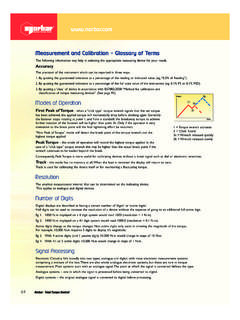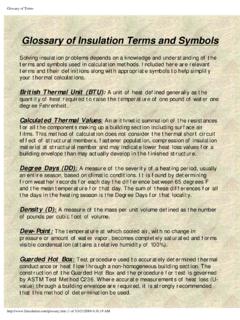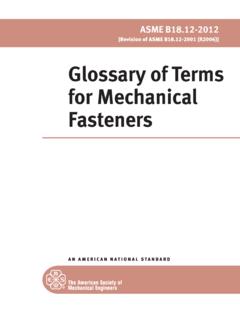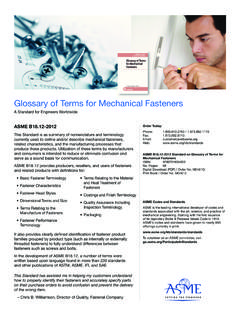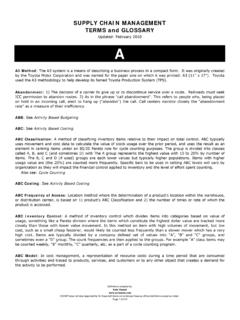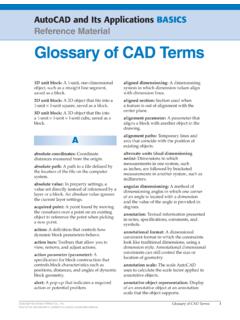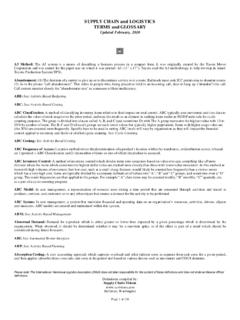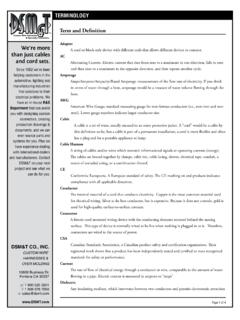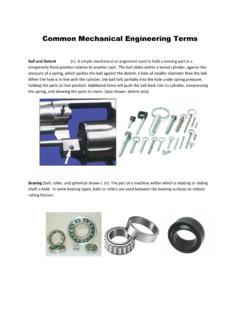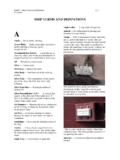Transcription of GLOSSARY OF TERMS INDEX - The Bangladesh Accord on Fire ...
1 GLOSSARY OF TERMS . INDEX . GLOSSARY of Structural TERMS ..2. GLOSSARY of Electrical TERMS ..7. GLOSSARY of Fire Safety TERMS ..10. 1|11. GLOSSARY OF STRUCTURAL TERMS . Aggregate: The stones and sand (coarse and fine aggregate respectively) used as a filler in concrete, asphalt etc. Angle: Steel angle: a steel section whose cross-section is L-shaped. Arch: A basic form of masonry construction over window and door or other openings in Victorian and older buildings. They exert horizontal thrust at their bearings. Ballast: Mixed size aggregate (sand, gravel). Beam: A horizontal member of structure that carries vertical loads along its length. Bending moment: Bending Moment is the reaction induced in any structural member when an external force is applied to it causing the element to bend. Unit of bending moment is force X Distance. Block: Building unit of a regular size usually made of solid or aerated concrete.
2 Bolt: Threaded fastener used (with a nut and washers) for connecting building components, particularly steel and/or timber. Bond: The arrangement or pattern of bricks (or other masonry units) in a wall. Each unit should overlap the unit below by at least one quarter of a unit's length, and sufficient bonding bricks should be provided to prevent the wall splitting apart. Bonding plaster: A proprietary type of plaster with good adhesive properties. It must be used with care as it is hygroscopic, it will readily absorb atmospheric or rising moisture. Brace, Bracing: Diagonal members (or rigid members/ shear wall) providing lateral stability to a building structure. Brick: Building unit of a regular size usually made of baked clay. Brick tie: A metal or plastic component to tie together the two leaves of a cavity wall. Older galvanized ties tend to rust away and have to be replaced.
3 Cantilever: Overhanging beam, roof or floor slab supported from one side only. Cement: A powder which when mixed with water forms a paste that hardens with time. Cement is mixed with sand to make mortar or render, and with stone chips added it is known as concrete. Cement mixer: Mechanical device consisting of a rotating drum with fixed paddles inside, used for mixing cement with aggregate and water to produce concrete, mortar, or any other cement-based mixture. Channel: A structural steel component, which is C-shaped in cross section. Circular hollow A structural steel component in the shape of a round tube. section: Cladding: The separately-applied exterior finish ( ceramic brick) of a framed building. Coarse aggregate: Any aggregate larger than fine aggregate. Gravel. Available with a maximum size of 10, 20 or 40mm. Compression: The pressing force experienced in a column or in the top flange of a beam Computer aided The type of computer program with which technical drawings are design (CAD): prepared.
4 Concrete: An artificial stone-like substance obtained by mixing large and small stones and sand with cement and enough water to make the mix workable. Concrete (like the stone minerals from which it is made) is strong in compression but weak in tension. Corrugated sheet: Sheet formed into a ridged shape, used for roofing and cladding. 2|11. Cure: Curing is the maintenance of moisture content which influences the hardening of concrete. Dead load: The weight of the materials that form a permanent part of the structure, as opposed to imposed load. Design check: Evaluation of the design to determine whether it conforms to the design brief and can be expected to provide a safe engineered solution. Development Length to which a reinforcing steel element must be anchored into length: concrete for it to work at full capacity Dowel: (Concrete) A steel bar for transferring load across a joint.
5 Effective length: A concept used in the design of structural members. May be more or less than the actual length to compensate for the degree of restraint of the ends of the member, a member which is more rigidly held at the ends being stronger. Engineering Engineering bricks are a type of brick used where strength, low water brick: porosity or acid resistance are needed. Fine aggregate: Sand used in making concrete, mortar etc. Flange: The top and bottom (horizontal) plates of an I- or H-beam. The top and bottom flanges of a beam are usually in compression and tension respectively Foot: Unit of length in the Imperial system; one-third of a yard, equal to Force: That which can accelerate a mass. An example of a force is weight, which acts to accelerate any mass towards the center of the earth. Formwork: A steel or wood mould into which concrete is cast. Foundation The part of a building or structure on which the building rests, which transmits load to the soil.
6 Common foundations are footing, raft or piled. Gravel: Naturally occurring ballast or course aggregate. Groundwork: Foundations, drainage, levelling and other building operations involving digging. Grout: Cement mixed with enough water to make it runny, used to fill a gap under the base of a steel column. Also the filler between wall tiles. H-section: A steel component shaped in cross-section like an H. Handrail: A length of material at hand height at the side of a staircase or landing. High tensile steel: A grade of steel stronger than mild steel, which may be used both in structural steelwork and concrete reinforcement. Hoist: An elevator for lifting goods usually, people up a scaffold. Hollow section: A tubular structural steel member. I-section: A structural steel section shaped like an I. Imposed load: The weight of furniture, people, storage, and any other non-permanent loads.
7 Jointing: The process of finishing the mortar between bricks or other masonry units at the time of building, as opposed to pointing the joint later. Joist: (Timber) Horizontal member which is one of a group running parallel and close together, supporting a floor or flat roof. Lintel A short beam over a door or window opening; may be steel, concrete Live load: Imposed load due to occupation. Load bearing: Designed to support a load in addition to its own weight. Load factor: Engineers design structures to support loads, which are more than the maximum load expected. The actual loads are calculated as accurately as possible and then multiplied by the factor. 3|11. Masonry: In general usage this describes work constructed of stone, but technically the term masonry also includes brickwork and blockwork. Mass: A property of all matter. It is measured in, for example, grams.
8 Mass concrete: Unreinforced concrete, as often used in foundations or ground floor slab on soil where the added strength of reinforcement is not required. Mix: The proportions of the ingredients of concrete (cement, sand and brick/stone chips). Mortar: A binder for masonry (cement and sand). Newton: The principal SI unit of force. Overstress Element which is stressed beyond its design capacity Partition: A non load bearing wall between rooms or areas in a building such as 5 wall. Permissible Stress that can be sustained safely. Codes of Practice for structural stress: design used to specify permissible stresses with which the actual stress was to be compared. Pile: A foundation consisting of a deep column extending down into the ground, used when the foundation needs to get support from a deeper and stronger or more stable layer. Pile cap: A (normally reinforced concrete) structure transferring loads from the building into the piles.
9 Pitch: Of roofs, the angle of the rafters from the horizontal. Traditionally the pitch was expressed as the number of vertical inches corresponding to twelve horizontal inches, thus a 45 degree roof was described as a twelve inch pitch. Plaster: The material which is spread to leave a smooth surface on a wall or ceiling. The main binding material may be cement and have a filler like sand. Plumb: Vertical or verticality, measured using a plumb-line or plumb-rule or these days a spirit level. Portal frame: A structural frame consisting of two columns and a cross- beam, with rigid connections. Often used for single-storey warehouses and workshops. The crossbeam is often formed as two rafters to make a pitched roof shape. Precast concrete: Concrete components made in a factory or yard and transported to the site. Prestressed Concrete strengthened with steel wires, which are stressed before the concrete: concrete is poured.
10 Progressive The process wherein the collapse of part of a building leads to the collapse: collapse of an adjacent part in 'house of cards' fashion. Purlin: A horizontal structural member which supports a sloping roof covering, with or without rafters, and which carries the roof loads to the primary framing members Rafter: Sloping structural member supporting a roof. Ready-mixed Concrete mixed in a batching plant and delivered in ready-mix trucks. concrete: Rectangular A structural steel component in the shape of a steel tube with a hollow section: rectangular cross section. Reinforcement: (Also known as rebar). Steel bars for reinforcing concrete. They are bent into special shapes according to the Engineer's bending schedule, and fitted into the correct position by a skilled operative called a steel fixer. 4|11. Reinforced Concrete reinforced with steel bars to make a versatile structural concrete: material, which is very strong in bending, shear, tension and compression, unlike plain concrete, which is strong only in compression.
